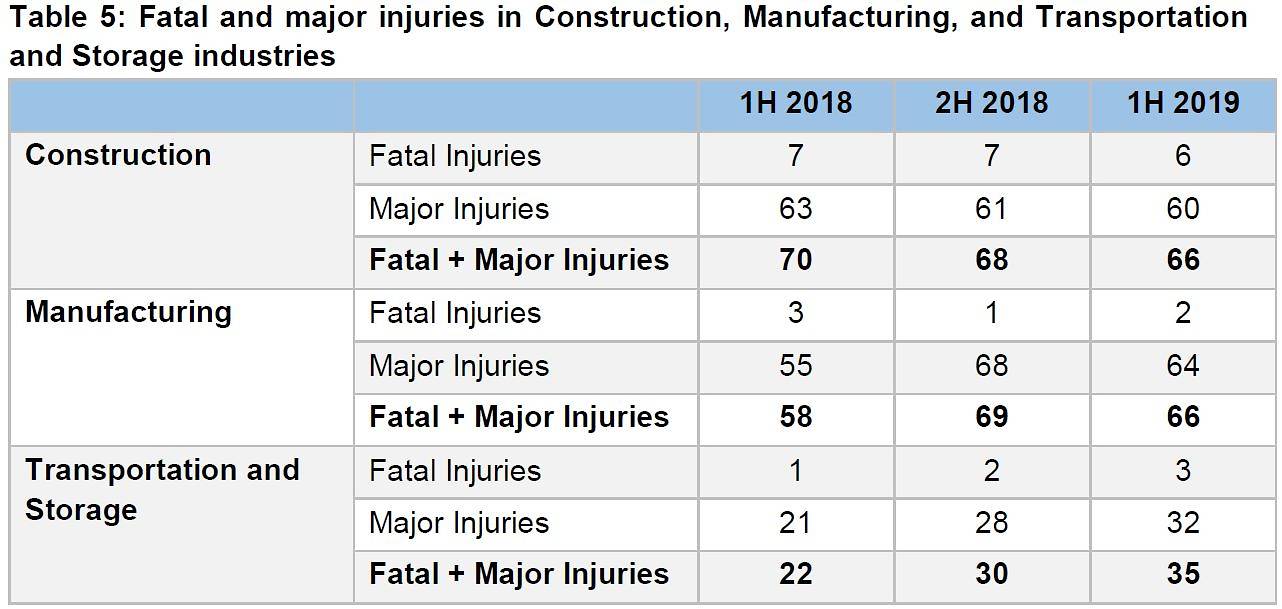SINGAPORE: The number of workplace deaths in Singapore fell to 17 in the first half of the year, but more workers suffered injuries, according to figures released by the Ministry of Manpower (MOM) on Monday (Sep 30).
The number of deaths was slightly fewer compared to the same period last year, when 18 workers were killed, and was the lowest figure since 2012 when the ministry started tracking fatality data for all workplaces.
However, the 12-month rolling fatal injury rate remained unchanged at 1.2 per 100,000 employed people as at the end of June this year.
READ: 41 people died in 2018 after suffering injuries in the workplace: MOM
Non-fatal workplace injuries rose by 8 per cent, from 6,073 cases in the first half of 2018 to 6,561 cases in the first half of 2019.
The ministry called for “vigilance” in the construction, manufacturing and transportation and storage industries, with these industries representing the top three sectors with the most workplace injuries.
The construction industry remained the top contributor of fatal injuries, with 35 per cent of total workplace fatal injuries.

(Source: Ministry of Manpower)
The number of workers seriously injured in workplace accidents has also become more evenly spread across diverse industries, said MOM.
More major injuries were seen in the lower-risk industries of accommodation and food services (from 16 in the first half of 2018 to 34 in the first half of 2019), wholesale and retail trade (from 15 to 21) and professional services (from five to 10).
FALLS FROM HEIGHT STILL KEY CONCERN
Falls from height remained a key concern, said MOM, with four such incidents resulting in deaths in the first half of the year, one more than the same period last year. Two of these happened in the construction industry.
Fatalities due to the collapse or failure of structure and equipment increased to three cases in the first half of 2019 from one case in the same period last year, while vehicular-related deaths remained at four cases in both periods.
Slips, trips and falls remained as the top cause of both major and minor injuries.
Major injuries from such incidents decreased from 111 in the first half of 2018 to 87 in the first half of 2019, but minor injuries increased by 8 per cent from 1,630 to 1,757.
MOM also called for more attention to be paid to reducing machinery-related incidents, the second-most common cause of major and minor injuries.

(Source: Ministry of Manpower)
The number of dangerous occurrences – incidents with a high potential for multiple deaths – as well as the number of occupational diseases both fell.
The number of dangerous occurrences fell from 10 cases in the first half of 2018 to eight in the first half of this year, with five due to collapse or failure of structures and equipment while the others were due to fires and explosions.
The number of occupational diseases fell from 295 cases to 263.
Work-related musculoskeletal disorders, noise-induced deafness and occupational skin diseases made up the top three categories of occupational diseases.
NEARLY 300 COMPANIES FINED
In the first half of the year, MOM conducted around 2,500 inspections which uncovered more than 4,300 workplace safety and health contraventions.
It issued a total of 29 stop-work orders, with an average duration of four weeks.
A total of S$680,000 in composition fines was imposed on close to 300 companies during this period.
For the second half of the year, the ministry said it plans to conduct more inspections targeting industries such as construction, manufacturing and transportation and storage.
It will also conduct inspections in sectors which saw a rise in major injuries, such as accommodation and food services, and wholesale and retail trade industries.
“It is encouraging that the first half of 2019 recorded the lowest half-yearly number of fatalities,” said Mr Christopher Koh, director of the policy, information and corporate services department at MOM. “However, we cannot be complacent as non-fatal injuries continue to rise, including in industries that were previously less accident-prone.”
Authorities have recently amended the Work Injury Compensation Act to share claims data with all insurers, and this will help safer companies benefit from lower premiums, said Mr Koh.
READ: MPs call for better treatment of injured migrant workers as amended work injury law passed
“We will also publish injury statistics of companies, starting with the construction industry in 2020, so that safer companies will stand a better chance at securing business.”





